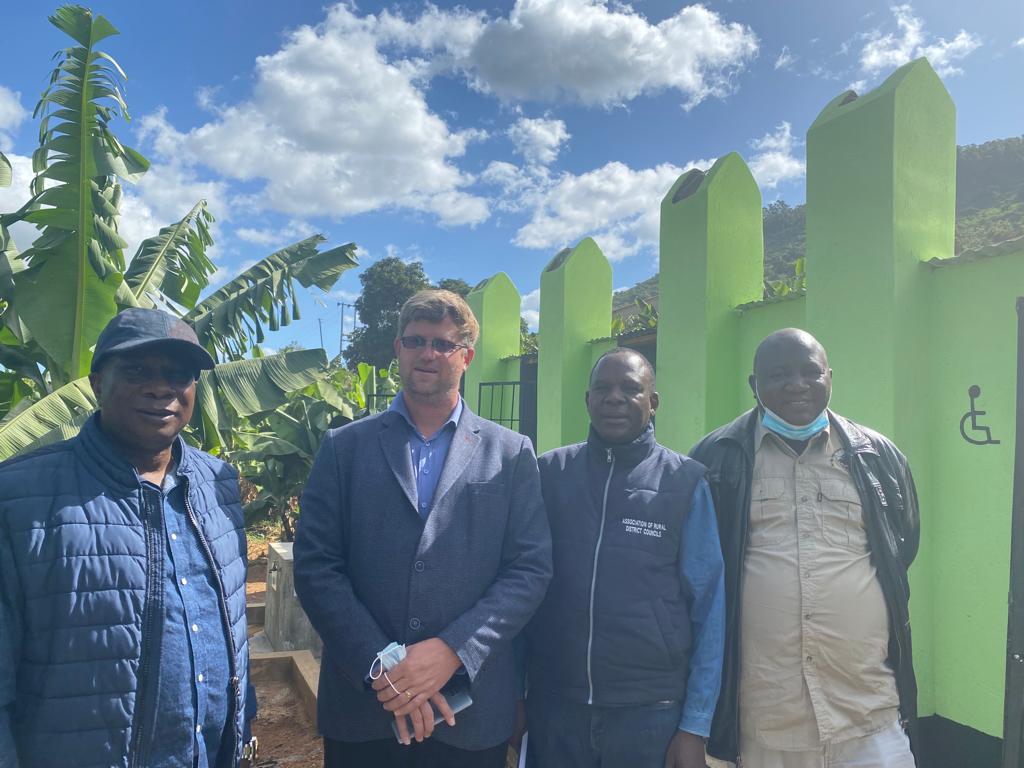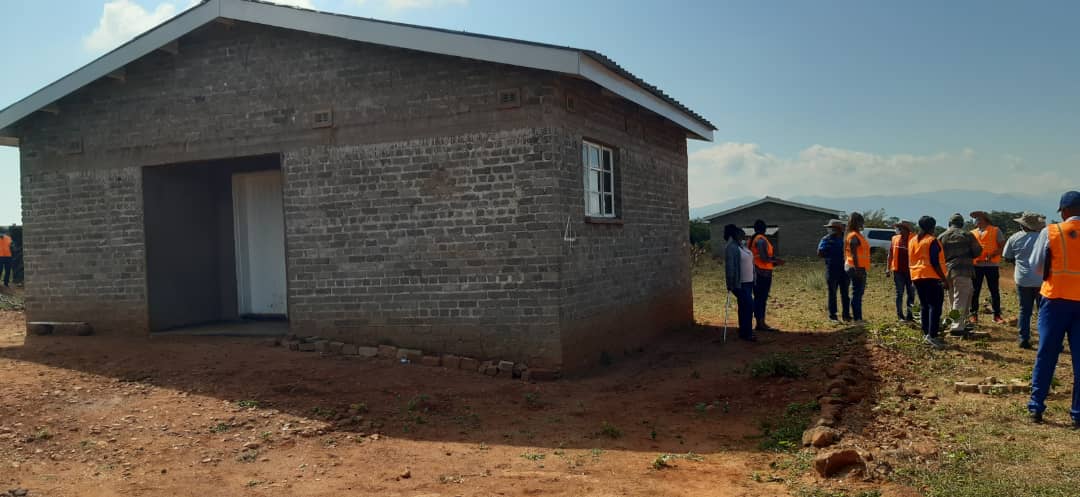|
Getting your Trinity Audio player ready…
|
Zimbabwe Idai Recovery Project (ZIRP) – a four-year project funded by the World Bank, in response to the devastating impact of Cyclone Idai in nine target districts in three provinces: Bikita, Buhera, Chimanimani, Chipinge, Chikomba, Gutu, Mutasa, Mutare Urban, and Mutare Rural, as well as locations with internally displaced populations (IDP’s) and refugees, is bearing positive fruits.
In his address, while receiving delegates on the tour of the areas affected by Cyclone Idai and the recovery projects put in place to assist the survivors, Hon Joshua Sacco, the Member of the House of Assembly for Chimanimani East thanked partners for restoring the livelihoods of the local people.
“After Cyclone Idai, which was a very traumatic experience for us the people of Chimanimani, we lost lives, livelihoods, and infrastructure. The Government of Zimbabwe appealed to the international community to come and assist in the reconstruction. Through his Excellency, President Mnangagwa’s appeal, we saw many development partners coming on board including the United Nations through its agencies.
“We appreciate this because we had so many interventions. These include the construction of schools, hospitals, toilets and water systems, feeder roads under UNOPS, and so forth. We greatly appreciate all these interventions towards rebuilding people’s lives and we hope these kinds of relationships will continue,” Hon Socco said.

From the United Nations partnership role under Under ZIRP, the United Nations Office for Project Services (UNOPS) takes on the full project management role, with implementation carried out by 8 other specialized UN Partners (FAO, IOM, UNICEF, UNOPS, UNFPA, UNESCO, WFP, WHO) through UN-to-UN agreements; under one grant for the Zimbabwe Idai Recovery Project.
This 4-year $72mil project funded by the World Bank is unique in many ways.
“This is the first time the World Bank has engaged one UN agency to manage a “consortium” of 8 UN agencies under the One Project – One Team approach in Zimbabwe. The UN agencies through joint effort are integrating their activities and leveraging each other’s comparative advantage which translates to a multiplied and greater impact on cyclone-affected communities.
“ZIRP is a multi-sectoral response to a natural disaster addressing immediate recovery needs and transitioning to medium term recovery, thus covering the nexus and ensuring sustainability and resilience. It is also a flexible framework which allows effective and efficient response to the needs of the community in line with the priorities of the Government. For instance, when the COVID-19 pandemic hit Zimbabwe, ZIRP reprogrammed the activities under its sectors to provide critical PPE supplies and build the capacity of health facilities for case management and disease surveillance,” Mr. Sirak Gebrehiwot, the United Nations Zimbabwe’s Chairperson of Communication told journalists ahead of a tour of projects resulting from a joint partnership between the UN and the Government of Zimbabwe in Chipinge and Chimanimani today as part of the UN Workshop on Development Reporting.
ZIRP has demonstrated how collaboration and coordination with the Government of Zimbabwe and within UN agencies’ specialist areas can amplify the benefits to vulnerable communities.
Addressing journalists at the workshop in Mutare yesterday, Mr. Edward Kallon, the UN Resident and Humanitarian Coordinator for Zimbabwe said the UN in support of Zimbabwe’s efforts towards attaining Agenda 2030 and the 17 Sustainable Development Goals by 2030, delivered USD 523 million in a form of various development and recovery projects in 2021.
“In this regard, the UN system supported food security; gender equality; water, hygiene, and sanitation; education; economic empowerment; community resilience, and targeted relief assistance to those most in need amongst others.
“In 2021, the United Nations facilitated through technical and financial support, the launch of the national policy on inclusion of persons with disability; established national mechanisms for the prevention of gender-based violence through the High-Level Political Compact; and the national policy on social protection, to provide coordinated support to vulnerable communities and those affected by COVID-19,” Mr. Kallon said..
He added that the UN has facilitated a nationwide food systems dialogue and continued to implement sustainable resilience-building projects, which made a significant contribution to the Food and Nutrition Security outcomes, i.e., equipping communities to adapt to climate change and build resilience for household food and nutrition security.
The UN in Zimbabwe implemented arguably the largest resilience programme in Zimbabwe, covering 18 districts and executed through seven (7) consortia. The programme strengthened the capacities of vulnerable communities to proactively make decisions in responding to severe economic, environmental, climatic, and social shocks and stresses.
The ZIRP has considerable achievements to date. Under the health cluster, UNOPS CI and WHO are working together to rehabilitate the incinerator at Mutambara, as the hospital generates a large amount of medical waste and also supports the waste disposal of several smaller health centres in the area. The facility generates an average of 45kgs of medical healthcare waste streams per month. Outreach sites generate on average of 1.2kg -1.5kg (Mashonjowa, Mhandarume, Mutsiyabako, Ruwedza A&B, Nyambeya, Mushakata, Tabanchu, Maraisi, and Hanzi) of healthcare waste per month which is also incinerated at Mutambara.
Under the gender-based violence surveillance and support cluster, mobile one-stop centres are set up within Mutambara Mission hospital on a rotational basis. The Hospital is an entry point for accessing GBV services for patients who access the facilities for broader health-related assistance. The space at Mutambara allows for private, confidential consultations for all walking-in patients.
The set up close to the Maternity waiting home has enabled increased access to GBV services also for clients of the MWHs. When Mobile One Stop Center (OSCs) are not on site at Mutambara Hospital, the Mobile OSC teams provide continuous referrals including transport support to in need survivors for referrals to the hospital. The closure of the health intervention under WHO has posed challenges in free and easy access for survivors at mobile one-stop clinics but UNFPA has been able to mitigate this by working with a registered nurse from the hospital.
Under the WASH cluster, the Hlabiso Clinic water scheme was built under Zimbabwe Idai Recovery Program (ZIRP) in Chimanimani. ZIRP is Funded by World Bank, a fund managed by UNOPS and UNICEF, and implemented by Welthungerhilfe (WHH). The objective of the project is to provide adequate, safe, and sustainable water supply to communities affected by Cyclone Idai. The project was done by the community with guidance and assistance from Chimanimani RDC skilled personnel. Welthungerhilfe provided construction materials, project coordination, engineering expertise, and training facilitation.
At Ndakopa Primary School, latrines were built under the Zimbabwe Idai recovery Program (ZIRP) in Chimanimani. The school is located in Mukondomi Village, which is located in ward 21, Chimanimani under Chief Ngorima.
Under the education cluster under the ZIRP project, at Ndakopa Primary School, UNICEF’s Education mandate was to procure and distribute education and learning supplies to ensure education quality and improve learning outcomes for learners from 134 cyclone affected schools in the 8 affected districts in Manicaland, Masvingo, and Mashonaland East provinces. In response to the COVID-19 pandemic, UNICEF procured and distributed hygiene kits as part of preparing schools for re-opening and the prevention of the spread of COVID-19 in schools.
Turning to the community infrastructure and resilience-building, Tiya ward 16 Chimanimani under Biriwiri has a total population of 11732. There are 122 Community workers working on the rehabilitation of the Tiya access road, 54 of the workers are women. Tiya access road provides access to two schools, Tiya Primary, and Secondary schools, and to 6 villages.
Chimanimani Radio Station (Chimanimani FM) is a community radio located in Chimanimani Township. The community radio was established to support community early warning messaging during cyclones or other emergencies. The specific objectives of establishing the radio are to strengthen the resilience of the region, therefore the project aims to reduce the vulnerability of communities in the Chimanimani and Chipinge Districts to natural disasters, such as floods, droughts and landslides and to enhance water resources and ecosystem services management in response to the uncertainty of future climate change.
Ther is also a success story at Runyararo Settlement, a new site that was established at the former Westend Farm to resettle people who were displaced by Cyclone Idai.
This is one case in point of the Government and UN synergy, and profitable cooperation which started with the provision of temporary tents at Kopa and Ngangu to the displaced and final permanent modern homesteads at Runyararo for Cyclone Idai survivors.
